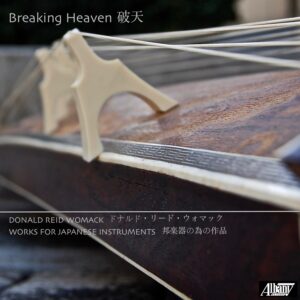Three Trees 三木
triple concerto
$25.00 – $250.00
shakuhachi, biwa, & 21-string koto
with ensemble of Japanese instruments
尺八、琵琶、二十絃箏による協奏曲
- Tree of Life 生命の木
- Shimmering Bamboo Sea きらめき揺れる、竹の海
- Hardwood 堅木
23:00
2013

Recorded on the album Breaking Heaven 破天 (Albany Records)
INSTRUMENTATION 楽器
solo shakuhachi, solo biwa, solo 21-string koto
3 shakuhachi, shamisen, 2 perc, 3 21-string koto, 17-string koto
尺八ソロ、琵琶ソロ、3 箏ソロ 尺八、三味線、2 打楽器、3 二十絃箏、十七絃箏
Three Trees 三木 was written in honor of the late Minoru Miki, one of Japan’s most important composers of the late 20th and early 21st centuries, as well as a personal friend. Taking its inspiration from Miki’s name (三木), the characters of which literally mean “three” and “tree”, the piece is a triple concerto for koto, shakuhachi, and biwa. Each solo instrument is prominently featured in one movement, with each movement reflecting the characteristics of the wood from which the featured solo instrument is made. Thus, the work presents a musical embodiment of three trees (or, in the case of shakuhachi/bamboo, a tree-like grass).
The first movement, Tree of Life 生命の木, refers to Paulownia (桐), the genus of tree from which koto is made. Paulownia is known for its ability to regenerate from its existing root system after being harvested. As such it makes an apt metaphor for Miki’s lifework of internationalizing Japanese and other Asian instruments, which will continue to grow and flourish even after his passing, leading to new generations of composers writing for these instruments. The movement begins with solo koto playing a gently flowing pattern, which seems to regenerate itself repeatedly. Shakuhachi enters with a long-breathed lyrical melody, introducing a motive that will return throughout the three movements. The ensemble takes over and gradually builds to a climax, after which koto plays a cadenza. Beginning slowly and quietly, it builds to a fast and energetic conclusion, and leads directly into the next movement.
The second movement, Shimmering Bamboo Sea きらめき揺れる竹の海, suggests a beautiful bamboo grove, shimmering as sunlight and shadows combine with a gentle breeze to create an ephemeral and magically serene effect. Throughout the movement, the music moves in and out of measured time, with solo shakuhachi playing numerous short cadenzas in alternation with the full ensemble. Initially simple and spacious, the shakuhachi’s role gradually becomes more active, eventually building to a sustained melodic line and a reappearance of the main motive. After a section that alludes to the opening idea of the previous movement, the movement ends quietly, with a cadenza for all three solo instruments followed a brief coda.
The third movement, Hardwood 堅木, refers to the various hardwoods from which biwa is made, and has a hard-edged quality that contrasts with the first two movements. The movement begins quietly, emerging from the end of the second as if from mist, with a cadenza for solo biwa. As it becomes more active and faster, the ensemble and other soloists gradually join in and lead to a climax, where the main motive returns. A middle section features biwa on funky, syncopated lines that disintegrate into a quiet exchange of sounds between the soloists, along with percussion. The opening idea returns and builds to an even bigger climax, again with the main motive reappearing. A final brief cadenza featuring all three soloists leads to a wildly fast coda, and the piece finally explodes and dissipates into a hazy finish.

